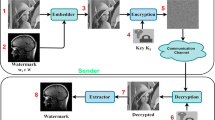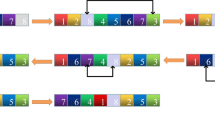Abstract
In this paper, we propose a new dual-image based reversible data hiding scheme through (7,4) Hamming code (RDHHC) using shared secret key. A block of seven pixels are collected from cover image and copied into two arrays then it is adjusted redundant Least Significant Bits (LSBs) using odd parity such that any error creation is encountered at the sender end and recovered at the receiver end. Before data embedding, we first complement the bit at shared secret position. After that, secret message bit is embedded by error creation caused by tamper in any suitable position except secret position and that error is detected as well as corrected at the receiver end using Hamming error correcting code. One shared secret position κ and one shared secret key ξ help to perform data embedding, data extraction and recovery of the original image. The secret data and original cover image are successfully recovered at the receiver end from dual stego image. Finally, we compare our scheme with other state-of-the-art methods and obtain reasonably better performance in terms of PSNR.












Similar content being viewed by others
References
Chang CC, Chou YC (2009) Information hiding in dual images with reversibility. In: 2009 Third International Conference on Multimedia and Ubiquitous Engineering. IEEE, pp 145–152
Chang CC, Kieu TD, Chou YC (2007) Reversible data hiding scheme using two steganographic images. In: TENCON 2007-2007 IEEE Region 10 Conference. IEEE, pp 1–4
Chang CC, Kieu TD, Chou YC (2008) A high payload steganographic scheme based on (7, 4) hamming code for digital images. In: 2008 International Symposium on Electronic Commerce and Security. IEEE, pp 16–21
Chang CC, Lu TC, Horng G, Huang YH, Hsu YM (2013) A high payload data embedding scheme using dual stego-images with reversibility. In: Communications and Signal Processing (ICICS) 2013 9th International Conference on Information. IEEE, pp 1–5
Fridrich J, Goljan M, Du R (2001) Invertible authentication. In: Photonics West 2001-Electronic Imaging (pp 197-208). International Society for Optics and Photonics
Fu MS, Au OC (2001) Halftone image data hiding with intensity selection and connection selection. Signal Process Image Commun 16(10):909–930
Kim HJ, Kim C, Choi Y, Wang S, Zhang X (2010) Improved modification direction methods. Comput Math Appl 60(2):319–325
Kim C, Shin D, Shin D (2011) Data hiding in a halftone image using hamming code (15, 11). In: Intelligent Information and Database Systems. Springer, Berlin Heidelberg, pp 372–381
Kieu TD, Chang CC (2011) A steganographic scheme by fully exploiting modification directions. Expert Syst Appl 38(8):10648–10657
Lee CF, Huang YL (2013) Reversible data hiding scheme based on dual stegano-images using orientation combinations. Telecommun Syst 52(4):2237–2247
Lee CF, Chen HL (2012) Adjustable prediction-based reversible data hiding. Digit Signal Process 22(6):941–953
Lee CF, Chen HL, Tso HK (2010) Embedding capacity raising in reversible data hiding based on prediction of difference expansion. J Syst Softw 83(10):1864–1872
Lee CF, Wang KH, Chang CC, Huang YL (2009) A reversible data hiding scheme based on dual steganographic images. In: Proceedings of the 3rd International Conference on Ubiquitous Information Management and Communication. ACM, pp 228–237
Lien BK, Chen SK, Wang WS, King KP (2015) Dispersed data hiding using hamming code with recovery capability. In: Genetic and Evolutionary Computing. Springer International Publishing, pp 179–187
Lien BK, Lin YM (2011) High-capacity reversible data hiding by maximum-span pairing. Multimed Tool Appl 52(2-3):499–511
Liao PS, Pan JS, Chen YH, Liao BY (2005) A lossless watermarking technique for halftone images. In: Knowledge-Based Intelligent Information and Engineering Systems. Springer, Berlin Heidelberg, pp 593–599
Lu ZM, Luo H, Pan JS (2006) Reversible watermarking for error diffused halftone images using statistical features. In: Digital Watermarking. Springer, Berlin Heidelberg, pp 71–81
Lu TC, Tseng CY, Wu JH (2015) Dual imaging-based reversible hiding technique using LSB matching. Signal Process 108:77–89
MA ZP, LI FY, Zhang XP (2013) Data hiding in halftone images based on hamming code and slave pixels. Journal Shanghai University (Natural Science Edition) 2:003
Ni Z, Shi YQ, Ansari N, Su W (2006) Reversible data hiding. IEEE Trans Circuits Syst Video Technol 16(3):354–362
Pan JS, Luo H, Lu ZM (2006) A lossless watermarking scheme for halftone image authentication. Int J Comput Sci Netw Secur 6(2b):147–151
Qin C, Chang CC, Hsu TJ (2015) Reversible data hiding scheme based on exploiting modification direction with two steganographic images. Multimed Tool Appl 74(15):5861–5872
Tian J (2003) Reversible data embedding using a difference expansion. IEEE Trans Circuits Syst Video Techn 13(8):890–896
Tseng HW, Hsieh CP (2009) Prediction-based reversible data hiding. Inf Sci 179(14):2460–2469
Westfeld A (2001) F5a steganographic algorithm. In: Information Hiding. Springer, Berlin Heidelberg, pp 289–302
Yu FX, Luo H, Chu SC (2009) Lossless data hiding for halftone images. In: Information Hiding and Applications. Springer, Berlin Heidelberg, pp 181–203
Author information
Authors and Affiliations
Corresponding author
Rights and permissions
About this article
Cite this article
Jana, B., Giri, D. & Kumar Mondal, S. Dual image based reversible data hiding scheme using (7,4) hamming code. Multimed Tools Appl 77, 763–785 (2018). https://doi.org/10.1007/s11042-016-4230-4
Received:
Revised:
Accepted:
Published:
Issue Date:
DOI: https://doi.org/10.1007/s11042-016-4230-4




